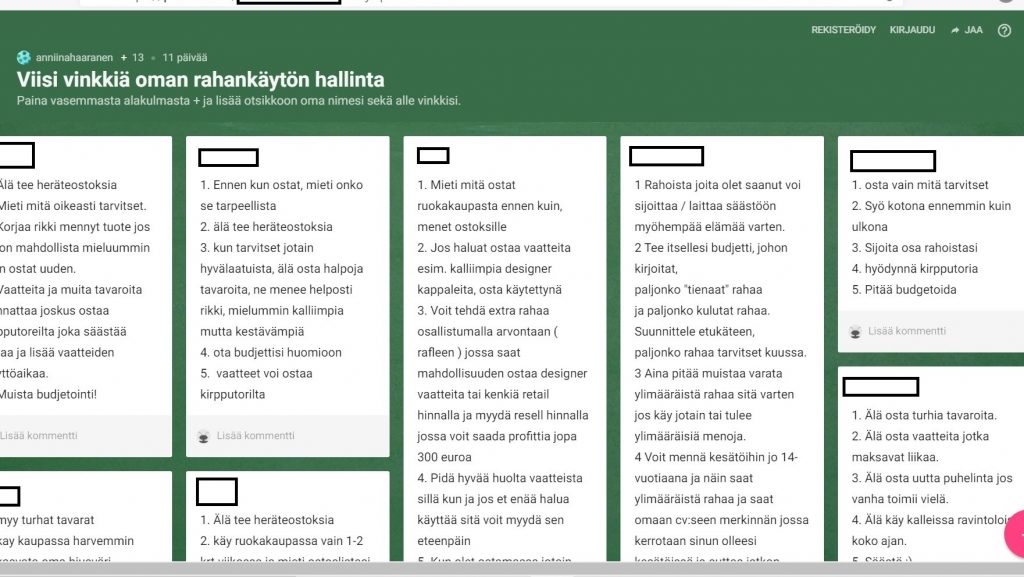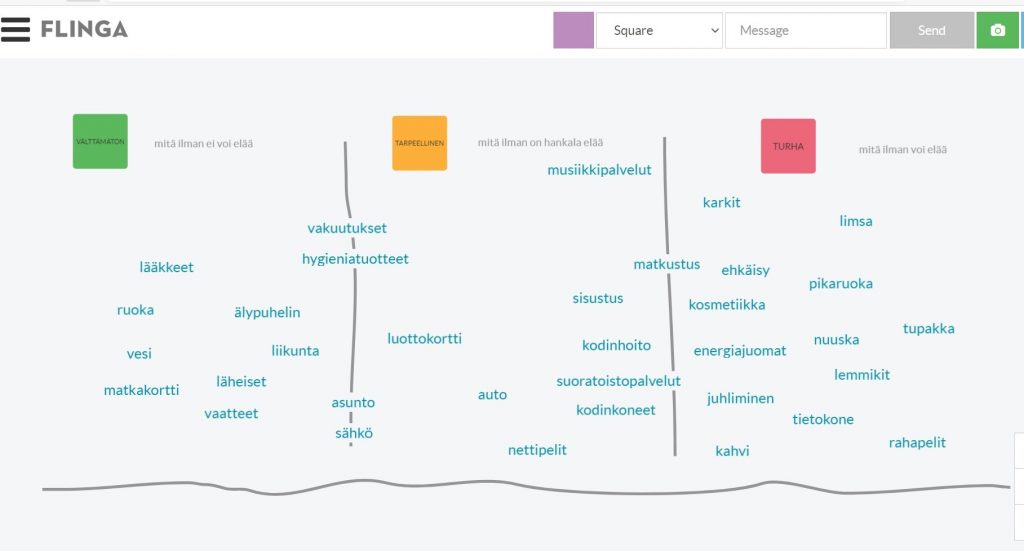Milla Erola, Anniina Haaranen, Alpo Kivijärvi & Tessy Tillander
Digital applications, social media and continuously developing technological solutions have changed permanently our daily life and therefore children need to develop important transferable skills, especially via Home Economics teaching. Media education is part of this skill teaching process, and it can be utilized in Home Economics and all other school subjects. Media literacy and competences for using media and digital applications are essential knowledge in modern world.

Picture 1. Padlet has a quite user-friendly and accessible interface. In this task students were asked to write down five different useful tips on how to use and manage money. Common advice related to saving money and sustainable consuming, like buying used products.
Home Economics is a crucial school subject, which provides a great set of different knowledge and skill sets that are necessary when it comes to society and mundane life. In other words, the aim of Home Economics and its curriculum is to adjust to a rapidly changing world and to grasp current societal phenomena. The Finnish teaching curriculum emphasizes the framework of 21-century skills, which are illustrated by OECD. Core themes of this framework, such as different social and cultural skills, co-operation, problem solving, and different forms of literacy are connected to Home Economics.
Since the Coronavirus pandemic, society and its functions have transformed, and people have had to adjust to changes that the pandemic caused. Many organizations and other units of society have deployed digital ways to operate. People must interact with each other online via different applications, which makes communication, co-operative working and interaction complicated. Unfortunately, not everybody have the same skill set to cope in a complex, digitalized world. Their agency, possibilities to learn and obtain important skills are endangered significantly. We need to set our focus on the factors that support unequal learning environments and structure both distance and traditional school teaching.
Consumer education is one main theme of the Home Economics educational content. Consumer education is a process where a person learns how to develop knowledge and skills which are useful, when it comes to consumer choices and decision making. Anticipation and future thinking along with other practical skills, such as buying and using products and services sustainably. Teaching methods that are used in consumer education should be based on students’ experiences and their world. We wanted to plan a creative and practical teaching experiment, where students can solve different problems which are related to their everyday life.

Picture 2. Teachers and students can compose simple and interactive charts from scratch with Flinga.
Our purpose was to integrate media education in our Home Economics teaching experiment and interact with students online. The aim was to tackle with various obstacles, which relate to distance learning and interaction. Arranging the online teaching experiment required scheduled and dense teamwork with numerous meetings and conversations. We carefully planned both lessons and practiced them through beforehand as well.
Distance learning makes demonstration and interaction more challenging. It is important for the teacher to have courage to try new methods and teaching tools. A creative mindset, team-oriented work and will to break boundaries makes successful online classes possible. Yet, digital applications could make teaching and learning hard and frustrating sometimes. Therefore, it is useful for teachers to test different applications, evaluate different solutions for educational use and re-evaluate decisions.
References
OECD. (2008). 21st Century Skills: How can you prepare students for the new Global Economy? Viitattu: 23.3.2021. Saatavissa: https://www.oecd.org/site/educeri21st/40756908.pdf
Finnish Competition and Consumer Authority. (2021). Consumer education. Päivitetty: 1.3.2021. Saatavissa: https://www.kkv.fi/en/consumer-education/
